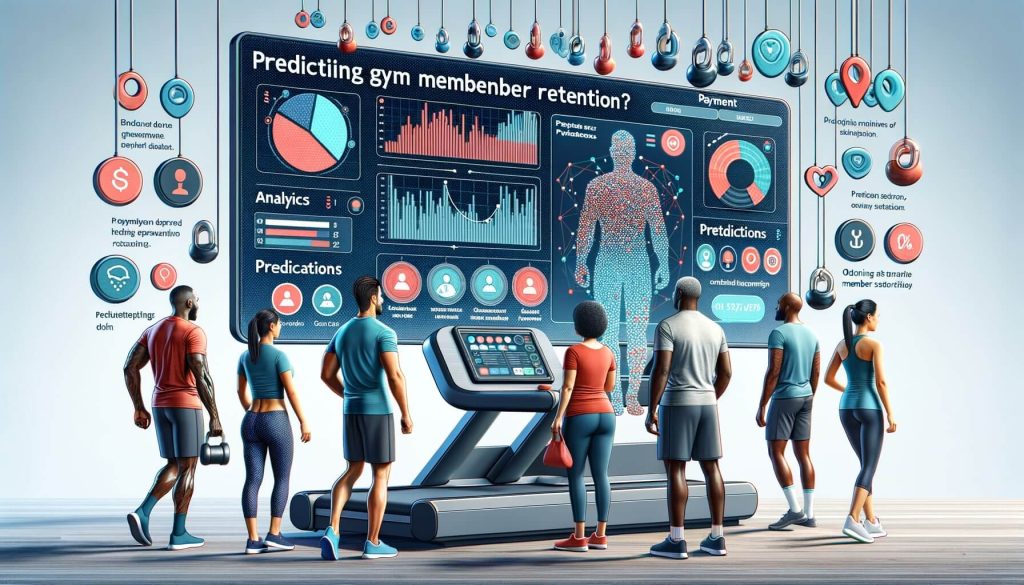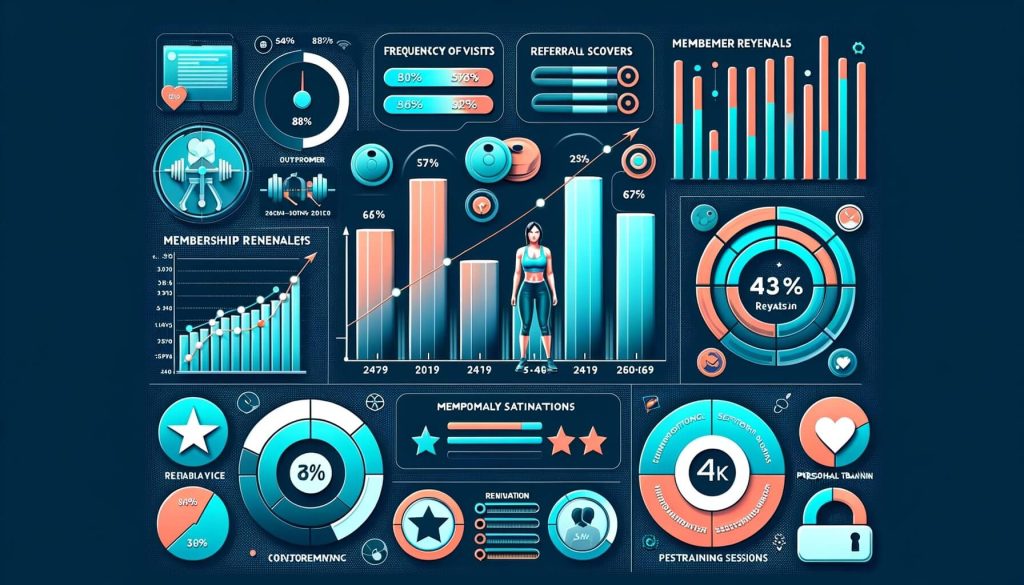
By dev February 5, 2025
In the highly competitive fitness industry, gym member retention is a critical factor for the success and growth of any fitness facility. Retaining existing members is not only more cost-effective than acquiring new ones but also contributes to a positive reputation and a loyal customer base. To achieve high member retention rates, gym owners and managers need to understand their members’ needs, preferences, and behaviors.
One valuable tool in this endeavor is payment data analysis, which can provide valuable insights into member retention patterns and help identify at-risk members. By leveraging payment data effectively, gym owners can implement targeted strategies to improve member retention and enhance overall customer satisfaction.
The Role of Payment Data in Predicting Gym Member Retention

Payment data, including membership fees, payment frequency, and payment history, can serve as a powerful predictor of gym member retention. By analyzing this data, gym owners can gain valuable insights into member behavior, identify trends, and make data-driven decisions to improve retention rates.
Payment data can reveal patterns such as members who consistently pay on time, those who frequently miss payments, or those who have recently canceled their memberships. These patterns can provide valuable clues about member satisfaction, engagement, and loyalty.
Collecting and Analyzing Payment Data: A Step-by-Step Guide

To effectively utilize payment data for member retention analysis, gym owners need to follow a systematic approach. Here is a step-by-step guide on collecting and analyzing payment data:
1. Data Collection: Gym owners should ensure that their payment systems are capable of capturing relevant data, such as membership fees, payment dates, and payment methods. This data can be collected through various channels, including online payment portals, POS systems, or manual record-keeping.
2. Data Organization: Once the payment data is collected, it should be organized in a structured manner for easy analysis. This can be done using spreadsheets or specialized software that allows for data sorting and filtering.
3. Data Cleaning: Before analysis, it is essential to clean the data by removing any duplicates, errors, or inconsistencies. This step ensures the accuracy and reliability of the analysis.
4. Data Analysis: The next step involves analyzing the payment data to identify trends, patterns, and key metrics related to member retention. This analysis can be done using statistical techniques, data visualization tools, or specialized software.
5. Interpretation and Insights: After analyzing the payment data, gym owners should interpret the findings and extract actionable insights. These insights can help identify at-risk members, understand their needs, and develop targeted retention strategies.
Key Metrics and Indicators to Consider in Gym Member Retention Analysis

When analyzing payment data for member retention, several key metrics and indicators should be considered. These metrics provide valuable insights into member behavior and can help identify areas for improvement. Some of the key metrics to consider include:
1. Churn Rate: Churn rate refers to the percentage of members who cancel their memberships within a specific period. A high churn rate indicates poor member retention and the need for targeted retention strategies.
2. Payment Frequency: Analyzing payment frequency can reveal patterns in member engagement and loyalty. Members who consistently pay on time are more likely to be satisfied and engaged.
3. Payment History: Examining payment history can help identify members who frequently miss payments or have irregular payment patterns. These members may be at a higher risk of canceling their memberships.
4. Membership Upgrades/Downgrades: Tracking membership upgrades or downgrades can provide insights into member satisfaction and their willingness to invest in additional services or features.
5. Average Lifetime Value: Calculating the average lifetime value of members can help assess the financial impact of member retention efforts. Higher lifetime values indicate stronger member loyalty and higher revenue potential.
Utilizing Payment Data to Identify At-Risk Members
One of the primary benefits of analyzing payment data is the ability to identify at-risk members. By identifying members who are more likely to cancel their memberships, gym owners can proactively intervene and implement targeted retention strategies. Here are some strategies for utilizing payment data to identify at-risk members:
1. Late Payment Analysis: Analyzing members who frequently make late payments or have a history of missed payments can help identify those who may be at risk of canceling their memberships. These members may be experiencing financial difficulties or dissatisfaction with the gym’s services.
2. Cancellation Patterns: Examining the payment data of members who have recently canceled their memberships can provide insights into common patterns or reasons for cancellation. This information can help gym owners address these issues and prevent future cancellations.
3. Payment Declines: Tracking payment declines can help identify members who may be experiencing issues with their payment methods or financial situations. Proactively reaching out to these members and offering assistance can help retain them.
4. Membership Renewal Analysis: Analyzing the payment data of members who have recently renewed their memberships can provide insights into their decision-making process. Understanding why members choose to renew can help replicate these factors and improve overall retention rates.
Strategies for Improving Gym Member Retention Based on Payment Data Insights
Once at-risk members have been identified through payment data analysis, gym owners can implement targeted strategies to improve member retention. Here are some effective strategies based on payment data insights:
1. Personalized Communication: Utilize payment data to segment members based on their payment history, preferences, and engagement levels. Tailor communication and offers to each segment to enhance member satisfaction and engagement.
2. Incentives and Rewards: Offer incentives and rewards to members who consistently pay on time or renew their memberships. This can include discounts, freebies, or exclusive access to special events or classes.
3. Membership Upgrades: Identify members who have been consistently paying their fees and offer them opportunities to upgrade their memberships. This can provide additional value to members and increase their loyalty.
4. Proactive Outreach: Reach out to members who have missed payments or experienced payment declines. Offer assistance, flexible payment options, or temporary membership freezes to help them overcome financial difficulties and retain their memberships.
5. Enhanced Customer Service: Use payment data insights to train staff and improve customer service. Address common issues or concerns raised by members through payment data analysis and ensure prompt resolution.
Implementing Personalized Offers and Incentives to Boost Retention
Personalization is a key factor in improving member retention, and payment data can provide valuable insights for implementing personalized offers and incentives. By tailoring offers to individual members’ preferences and behaviors, gym owners can enhance member satisfaction and loyalty. Here are some strategies for implementing personalized offers and incentives:
1. Loyalty Programs: Develop loyalty programs that reward members based on their payment history, frequency, or duration of membership. Offer exclusive perks, discounts, or freebies to members who consistently demonstrate loyalty.
2. Referral Programs: Encourage members to refer their friends or family members by offering incentives such as discounted membership fees or additional services. Analyze payment data to identify members who frequently refer new members and reward them accordingly.
3. Personalized Discounts: Utilize payment data to identify members who have been consistently paying their fees and offer them personalized discounts or upgrades. This can provide an extra incentive for members to continue their memberships.
4. Specialized Classes or Services: Analyze payment data to identify members who have shown interest in specific classes or services. Offer personalized recommendations and discounts for these classes or services to enhance member engagement and satisfaction.
5. Anniversary Offers: Celebrate members’ anniversaries with personalized offers or rewards. This can include discounts on membership fees, free personal training sessions, or exclusive access to new facilities or equipment.
Leveraging Payment Data to Enhance Member Engagement and Satisfaction
Payment data analysis can also be leveraged to enhance member engagement and satisfaction. By understanding members’ payment behaviors and preferences, gym owners can tailor their services and offerings to meet their needs. Here are some strategies for leveraging payment data to enhance member engagement and satisfaction:
1. Flexible Payment Options: Analyze payment data to identify members who may prefer alternative payment methods or flexible payment options. Offer options such as monthly, quarterly, or annual payment plans to cater to their preferences.
2. Automated Payment Reminders: Utilize payment data to send automated payment reminders to members who frequently miss payments or have irregular payment patterns. This can help improve payment compliance and reduce the risk of membership cancellations.
3. Member Feedback Surveys: Use payment data insights to identify members who have recently renewed their memberships or made consistent payments. Send them feedback surveys to gather insights on their satisfaction levels and areas for improvement.
4. Personalized Recommendations: Analyze payment data to understand members’ preferences and interests. Use this information to provide personalized recommendations for classes, services, or amenities that align with their interests.
5. Exclusive Access: Offer exclusive access to new facilities, equipment, or classes to members who have demonstrated loyalty through consistent payments. This can create a sense of exclusivity and enhance member satisfaction.
Addressing Common Challenges in Using Payment Data for Retention Prediction
While payment data analysis can provide valuable insights into member retention, there are some common challenges that gym owners may face. Addressing these challenges is crucial to ensure accurate and effective retention prediction. Here are some common challenges and strategies to overcome them:
1. Data Privacy and Security: Ensure that proper data privacy and security measures are in place to protect members’ payment data. Comply with relevant regulations and implement robust security protocols to maintain member trust.
2. Data Integration: Integrate payment data with other relevant data sources, such as member demographics or attendance records, to gain a comprehensive understanding of member behavior. This integration can provide a more accurate prediction of member retention.
3. Data Quality and Accuracy: Regularly audit and clean payment data to ensure its quality and accuracy. This includes removing duplicates, correcting errors, and addressing any inconsistencies in the data.
4. Data Interpretation: Develop a clear framework for interpreting payment data insights and translating them into actionable strategies. This can involve collaboration between data analysts, marketing teams, and gym management to ensure effective decision-making.
5. Staff Training and Buy-In: Provide training to staff members on the importance of payment data analysis and its role in member retention. Encourage buy-in from staff members to ensure the successful implementation of retention strategies based on payment data insights.
FAQs
Q1. How can payment data analysis help improve gym member retention?
Payment data analysis can help improve gym member retention by providing insights into member behavior, preferences, and satisfaction levels. By identifying at-risk members and implementing targeted retention strategies, gym owners can enhance member engagement and loyalty.
Q2. What are some key metrics to consider in gym member retention analysis?
Some key metrics to consider in gym member retention analysis include churn rate, payment frequency, payment history, membership upgrades/downgrades, and average lifetime value. These metrics provide valuable insights into member behavior and can help identify areas for improvement.
Q3. How can gym owners utilize payment data to identify at-risk members?
Gym owners can utilize payment data to identify at-risk members by analyzing late payment patterns, cancellation trends, payment declines, and membership renewal patterns. These insights can help proactively intervene and implement targeted retention strategies.
Q4. What are some strategies for improving gym member retention based on payment data insights?
Some strategies for improving gym member retention based on payment data insights include personalized communication, incentives and rewards, membership upgrades, proactive outreach, and enhanced customer service. These strategies can enhance member satisfaction and loyalty.
Q5. How can gym owners leverage payment data to enhance member engagement and satisfaction?
Gym owners can leverage payment data to enhance member engagement and satisfaction by offering flexible payment options, automated payment reminders, member feedback surveys, personalized recommendations, and exclusive access to new facilities or classes.
Conclusion
In conclusion, payment data analysis plays a crucial role in predicting gym member retention and implementing effective strategies to improve member engagement and satisfaction. By collecting and analyzing payment data, gym owners can gain valuable insights into member behavior, identify at-risk members, and develop targeted retention strategies.
By leveraging payment data effectively, gym owners can enhance member loyalty, increase revenue, and create a positive reputation in the highly competitive fitness industry. With the right approach and utilization of payment data, gym owners can achieve high member retention rates and ensure the long-term success of their fitness facilities.